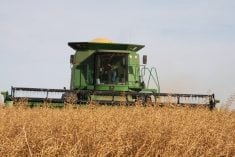Alberta sugar beet growers continue to see gains in yield and crop quality year over year, thanks to new genetics and 2009’s full adoption of Roundup Ready varieties. But can growers really expect the winning streak to continue? Arnie Bergen-Henengouwen, President of Alberta Sugar Beet Growers, (ASBG) says he believes there are still plenty of gains to be had, but they’ll be incremental gains from genetics, strong grower management practices and research.
“The research program is always testing new varieties and they’re always working on new genetics, so I think we’ll keep inching up,” Bergen-Henengouwen says. “I don’t expect the big advancements we’ve seen in the last ten years but I’m sure incrementally yield and quality continue to rise.”
Read Also

Claas brings 1000 Series SP forage harvesters to Canada
In mid-August, Claas unveiled its new line of Jaguar forage harvesters at an event in Visalia, California, deep in the heart of that state’s dairy region.
- Read more: How high can we push sugar beet yields?
- Read more: These aren’t your father’s sugar beets
Four-year rotation
The biggest concern for Canada’s sugar beet crop is, to date, a manageable one. Sugar beet cyst nematode threatens the crop in other sugar beet growing regions, and it’s a costly pest to manage. Alberta’s sugar beet sector imposes a strict four-year rotation that has so far managed to keep the pest at bay.
“We want to do everything we can to minimize the chance of bringing sugar beet cyst nematode in to our fields, and we don’t want to risk putting land out of production,” says Bergen-Henengouwen. “As a sector we have been adamant that we don’t want to go there because it would cost us too much.”
ASBG works closely with its only domestic partner, Lantic Inc. Peter Regitnig, research agronomist with Lantic Inc., says the sector won’t budge on rotation. Some sugar-beet growing regions of the U.S. are on tighter rotations, and growers there now have to apply chemical controls for sugar beet cyst nematode.
“We’re probably more rigid than anyone else in North America for rotation, and I think that has also helped us immensely with controlling some disease issues, even in things like root rot in sugar beets,” Regitnig says.
He notes that although Alberta is not immune to root rot diseases — and there are some pockets around — the region’s low humidity and cool nights make it one of North America’s most ideal locations for growing sugar beets.
Seeing yellow
With the widespread adoption of Roundup Ready seed, volunteer canola plants can present occasional headaches for sugar beet growers.
“We adopted Roundup Ready technology which has been very good for us, but now we need to evaluate solutions to getting Roundup Ready canola out of a field,” Regitnig says.
While Regitnig has done some work on chemical controls for Roundup Ready canola, Bergen-Henengouwen says to date the most effective way to get rid of it is also the most tedious: wait until the bright yellow flowers appear and send in a roguing crew to hand-pull each of the unwanted plants.
Doing more with less
Researchers continue to look at giving growers opportunities to produce more, using fewer resources. Improved equipment has helped in that department, Bergen-Henengouwen says.
“We’re all pivot irrigation so application efficiencies have changed and we’re quite a bit more efficient with water,” say Bergen-Henengouwen. He says seeding equipment has come a long way too, allowing for more precision with planting.
Regitnig says his research team is in the process of re-examining nitrogen fertilizer recommendations, to be sure they’re still optimal in light of rising yields and quality. If too much nitrogen fertilizer gets applied, sugar content goes down.
“We’re still looking at increasing efficiencies although they won’t be the huge gains we saw in applying fertilizer vs. not applying fertilizer, but we’re trying to make it more efficient over time,” Regitnig says.
Tweaking for processing advantages
The Lantic plant in Taber operates from October until February each year. Harvested sugar beets are stored in expansive piling grounds for several months until processing.
Regitnig stays current on changing practices in other growing regions, but he says they’re not always a fit for Canada’s climate. For example, some regions in the U.S. promote higher plant populations in the field. But Regitnig expects the increase in grower seed costs wouldn’t put them any farther ahead and beets may be smaller in size, creating more dense piles that would deteriorate faster in Alberta’s freeze-thaw weather patterns.
Bergen-Henengouwen sees promise in new genetics that will benefit sugar beet growers.
“Our growers jump on the different seed variety wagon when there’s increased yield or they see soil and moisture conservation — anything with proven environmental benefits,” he says. “We can always tweak management a little bit, but by and large we’ll see the biggest gains from genetics.”














